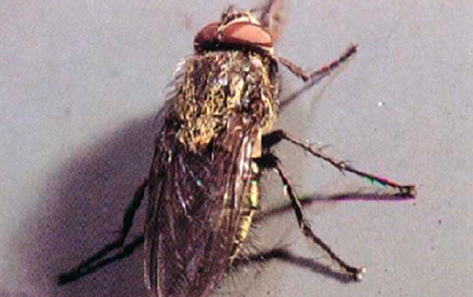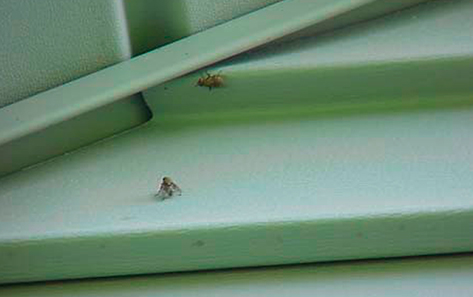Cluster Fly – Fact and Fiction
In the late winter or early spring, adult cluster flies (Pollenia rudis F.) will ‘magically’ appear in windows, in light fixtures or on ceilings of brightly lit rooms. The flies are frequently reported as ‘big house flies’ that are slow, lethargic and easy to swat and kill. Unlike other large related flies, cluster flies are not pests of decaying organic matter. They have not been associated with organisms of filth, nor any disease transmission. Cluster flies are structural pests based on their overwintering behavior.
In autumn, adult cluster flies will begin to seek out overwintering sites. Natural sites for over-wintering include: under tree bark, in tree holes, and in caves. Structures offer cluster flies very favorable overwintering shelter. Flies will congregate on the southern and western exposures of buildings as autumn day temperatures drop. Sensitive to heat sources, the adult flies will enter buildings through any crack or opening that exists into the structure.
Cluster flies commonly enter buildings around door and window frames, through eaves and soffits, through vents, and along unsealed trim work.
Once inside, the adult flies will go dormant inside wall voids, attics and other building spaces. It is not unusual to find thousands of overwintering flies ‘clustered’ together in a void of only a few square feet. On sunny days in late winter or early spring, growing warmth in the infested void will cause some adults to become active. Looking to escape, they will seek out bright lighted areas, thus appearing in windows and the light fixtures of suspended ceilings.
The most effective means of controlling cluster flies is physical exclusion. Seal cracks around doors and windows. Screen vents and soffit openings. Caulk around trim work to exclude fly entry. If cluster flies are a problem, you can assume that they will be an annual pest threat.
Pyrethroid insecticides have demonstrated effective residual control of cluster flies when applied at critical times of the year. Apply Temprid® FX on outdoor surfaces, around doors and windows, and areas where cluster flies may enter the building. Treat the entire building (all exposures). Contact local University Extension Services for treatment scheduling. In the northern U.S. the treatment period starts in August. In southern areas the treatment time is later in September.
Chemical treatment of overwintering cluster flies inside buildings is usually not recommended. Dusts and aerosols cannot penetrate the masses of insects harboring in voids. Control is incomplete and dead flies may attract scavenging pests such as dermestid beetles and ants next spring. If overwintering sites are accessible, the dormant cluster flies can be physically removed with a pest management-rated vacuum cleaner. Be prepared for removing significant amounts of insects. This author once removed 13, 30-gallon garbage bags of dormant cluster flies from a commercial structure in New York State.
For more information, contact your local Envu Pest Management & Public Health Representative.


